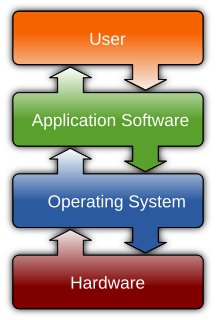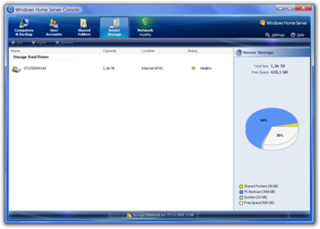Related Research Articles

Software is a collection of instructions and data that tell a computer how to work. This is in contrast to physical hardware, from which the system is built and actually performs the work. In computer science and software engineering, computer software is all information processed by computer systems, including programs and data. Computer software includes computer programs, libraries and related non-executable data, such as online documentation or digital media. Computer hardware and software require each other and neither can be realistically used on its own.

In computing, a database is an organized collection of data stored and accessed electronically from a computer system. Where databases are more complex they are often developed using formal design and modeling techniques.
In software engineering, multitier architecture or multilayer architecture is a client–server architecture in which presentation, application processing and data management functions are physically separated. The most widespread use of multitier architecture is the three-tier architecture.

Microsoft Access is a database management system (DBMS) from Microsoft that combines the relational Microsoft Jet Database Engine with a graphical user interface and software-development tools. It is a member of the Microsoft 365 suite of applications, included in the Professional and higher editions or sold separately.

A Wiki software is collaborative software that runs a wiki, which allows users to create and collaboratively edit pages or entries via a web browser. A wiki system is usually a web application that runs on one or more web servers. The content, including previous revisions, is usually stored in either a file system or a database. Wikis are a type of web content management system, and the most commonly supported off-the-shelf software that web hosting facilities offer.
Middleware in the context of distributed applications is software that provides services beyond those provided by the operating system to enable the various components of a distributed system to communicate and manage data. Middleware supports and simplifies complex distributed applications. It includes web servers, application servers, messaging and similar tools that support application development and delivery. Middleware is especially integral to modern information technology based on XML, SOAP, Web services, and service-oriented architecture.
An application server is a server that hosts applications.
A stored procedure is a subroutine available to applications that access a relational database management system (RDBMS). Such procedures are stored in the database data dictionary.

A web application is application software that runs on a web server, unlike computer-based software programs that are run locally on the operating system (OS) of the device. Web applications are accessed by the user through a web browser with an active network connection. These applications are programmed using a client–server modeled structure—the user ("client") is provided services through an off-site server that is hosted by a third-party. Examples of commonly-used web applications include: web-mail, online retail sales, online banking, and online auctions.
An application program is a computer program designed to carry out a specific task other than one relating to the operation of the computer itself, typically to be used by end-users. Word processors, media players, and accounting software are examples. The collective noun refers to all applications collectively. The other principal classifications of software are system software, relating to the operation of the computer, and utility software ("utilities").
In computer science and networking in particular, a session is a temporary and interactive information interchange between two or more communicating devices, or between a computer and user. A session is established at a certain point in time, and then ‘torn down’ - brought to an end - at some later point. An established communication session may involve more than one message in each direction. A session is typically stateful, meaning that at least one of the communicating parties needs to hold current state information and save information about the session history to be able to communicate, as opposed to stateless communication, where the communication consists of independent requests with responses.

The Windows Registry is a hierarchical database that stores low-level settings for the Microsoft Windows operating system and for applications that opt to use the registry. The kernel, device drivers, services, Security Accounts Manager, and user interfaces can all use the registry. The registry also allows access to counters for profiling system performance.
Essbase is a multidimensional database management system (MDBMS) that provides a multidimensional database platform upon which to build analytic applications. Essbase began as a product of Arbor Software, which merged with Hyperion Software in 1998. Oracle Corporation acquired Hyperion Solutions Corporation in 2007, as of 2009 Oracle marketed Essbase as "Oracle Essbase" and more recently, Essbase is offered as part of the Oracle Analytics Cloud. Until late 2005 IBM also marketed an OEM version of Essbase as DB2 OLAP Server.
Enterprise content management (ECM) extends the concept of content management by adding a timeline for each content item and, possibly, enforcing processes for its creation, approval and distribution. Systems using ECM generally provide a secure repository for managed items, analog or digital. They also include one methods for importing content to bring manage new items, and several presentation methods to make items available for use. Although ECM content may be protected by digital rights management (DRM), it is not required. ECM is distinguished from general content management by its cognizance of the processes and procedures of the enterprise for which it is created.
The Microsoft Jet Database Engine is a database engine on which several Microsoft products have been built. The first version of Jet was developed in 1992, consisting of three modules which could be used to manipulate a database.

Windows Home Server is a home server operating system from Microsoft. It was announced on 7 January 2007 at the Consumer Electronics Show by Bill Gates, released to manufacturing on 16 July 2007 and officially released on 4 November 2007.

SharePoint is a web-based collaborative platform that integrates with Microsoft Office. Launched in 2001, SharePoint is primarily sold as a document management and storage system, but the product is highly configurable and its usage varies substantially among organizations.
Microsoft SQL Server is a relational database management system developed by Microsoft. As a database server, it is a software product with the primary function of storing and retrieving data as requested by other software applications—which may run either on the same computer or on another computer across a network. Microsoft markets at least a dozen different editions of Microsoft SQL Server, aimed at different audiences and for workloads ranging from small single-machine applications to large Internet-facing applications with many concurrent users.

A user is a person who utilizes a computer or network service.
A mobile application, also referred to as a mobile app or simply an app, is a computer program or software application designed to run on a mobile device such as a phone, tablet, or watch. Mobile applications often stand in contrast to desktop applications which are designed to run on desktop computers, and web applications which run in mobile web browsers rather than directly on the mobile device.